I stood at the edge of Kīlauea’s caldera on Hawaii’s Big Island and faced the legendary Volcano House. Visiting Volcano House offers breathtaking views of one of the world’s most active volcanoes and connects you to Hawaii’s history.

Travelers have visited the hotel since the mid-1800s. This makes Volcano House a unique landmark filled with stories from every era.
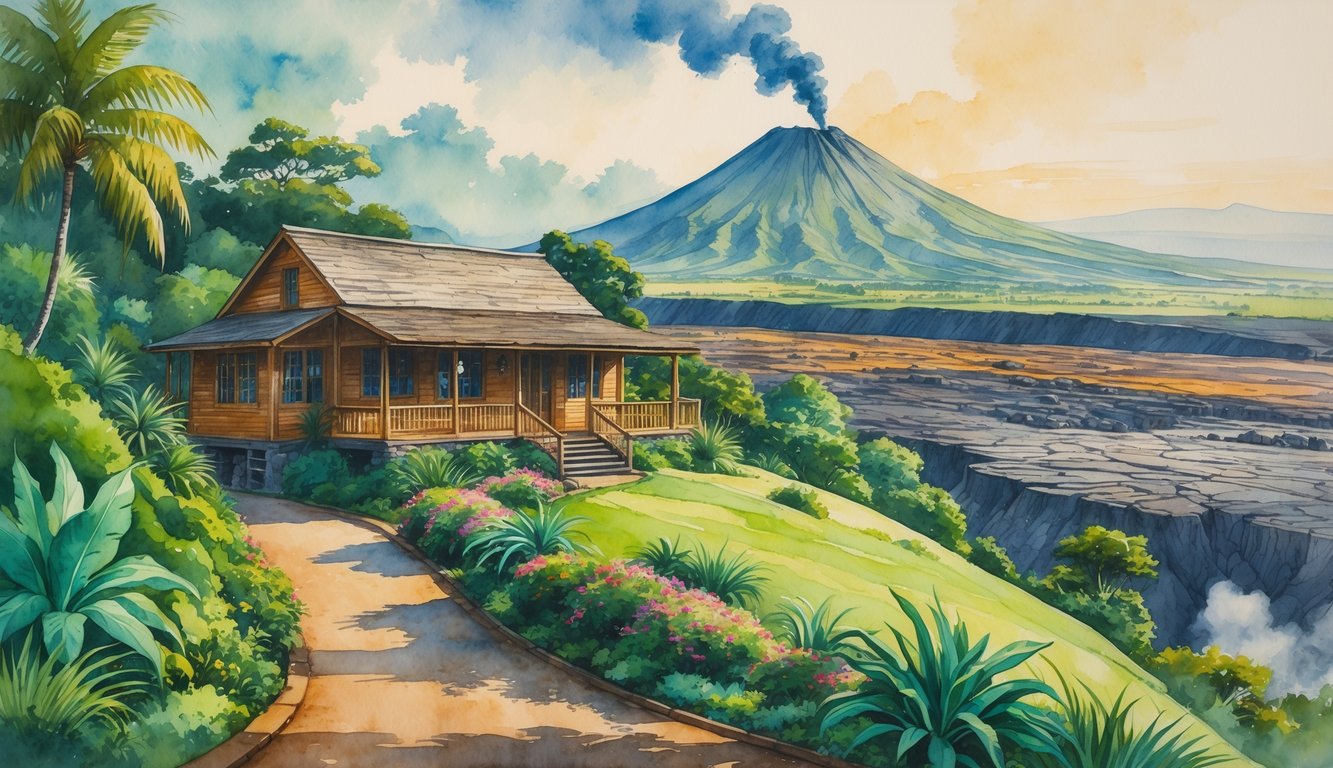
When I walked through its doors, echoes of the past surrounded me. Mark Twain once stayed here, and over the years, Volcano House changed and grew but kept its charm.
From the comfortable lounge, I gazed through endless windows at the steamy caldera. This view has drawn visitors for generations.
Whether you seek adventure or love exploring places with rich history, Volcano House has something special. Historic rooms and unbeatable views make this spot a must-see for anyone visiting Hawaii’s Big Island.
To learn more about its legacy and what it’s like to stay here today, you can read the Volcano House’s story.
The Rich History of Volcano House
Volcano House is more than a hotel. It stands as a living part of Hawaii’s past.
I am amazed by its transformation from a simple shelter to a well-known lodge. Many historic people have visited it.
Origins and Early Years
In 1846, Benjamin Pitman built a small, one-room shelter at the rim of Kīlauea Volcano. The original building was only 12 by 18 feet, made with grass and local ohia wood.
It looked nothing like the modern hotel. Pitman’s shelter gave travelers a safe place to rest after viewing the crater.
Over the years, new owners expanded the structure. By 1877, a new wooden building replaced the original and became known as the 1877 Volcano House.
This larger inn offered basic food and shelter to adventurous visitors. Its fame helped turn Kīlauea into a major tourist destination.
Today, the 1877 building houses the Volcano Art Center. It appears on the National Register of Historic Places.
Famous Visitors and Their Stories
Many well-known people have stayed at Volcano House. In 1866, Mark Twain visited and wrote about his experiences near the volcano.
The British writer Isabella Bird also visited and described what she saw in detail. George Lycurgus managed Volcano House and welcomed many guests during his time.
Jack London and Amelia Earhart both came to see the famous crater up close. Even President Franklin D. Roosevelt visited, adding to the hotel’s legacy.
Each guest left a mark on the place. Their stories still shape the strong cultural heritage of this historic hotel.
Major Renovations and Expansions
Several important expansions shaped Volcano House’s history. In 1891, the Victorian Addition gave the inn an elegant look and new amenities.
Pitman House, another nearby building, housed overflow guests. In 1941, builders replaced earlier structures with a new Volcano House designed by architect Charles W. Dickey.
The lodge expanded again in 1961, adding more rooms and modern features. The Hawai’i Volcanoes Lodge Company managed the hotel for many years, keeping its old-fashioned charm while updating for comfort.
These changes kept the property in good shape. I enjoy both its rustic past and modern comforts when I visit.
Volcano House Through the Decades
Volcano House has kept its important place on the edge of Kīlauea through good times and hardship. During the Great Depression, the hotel operated and gave people work.
The building witnessed new eras as transportation improved and more tourists arrived. The story of Volcano House includes repairs, fires, and careful rebuilding.
Every decade brought new guests who made memories near one of the world’s most active volcanoes. Old photographs, guest books, and the evolution of the Volcano House show this history.
Volcano House and Hawaii Volcanoes National Park
The Volcano House stands at the heart of Hawai’i Volcanoes National Park. The hotel lets me enjoy comfort and direct access to volcanic landscapes.
It also supports conservation and visitor education in the area.
Location and Setting
Volcano House sits on the rim of Kīlauea caldera and offers amazing views of the volcano and Halemaʻumaʻu crater. When I step outside, lava fields, steam vents, and lush rainforests are only steps away.
Unlike other Hawaii hotels, this one stands inside the national park, surrounded by protected volcanic land. Being so close to the volcanic action gives me a real sense of adventure.
I can wake up and see smoke rising from the crater, especially from many rooms and the restaurant. This constant connection to nature and Pele, the volcano goddess, makes the setting unforgettable.
Integration with the National Park
Volcano House is the only hotel inside Hawai’i Volcanoes National Park. The National Park Service and the hotel work together to protect native species, maintain historic buildings, and share information about the volcano’s history and science.
During my stay, I found easy access to trails, guided walks, and ranger programs. Exhibits in the lobby and public spaces help me learn about the area’s cultural and ecological significance.
Park entrance fees are separate from room rates. Staying here means I am already inside the park boundary.
This makes it simple to explore the summit area at sunrise or late at night, when the glow from the crater is especially striking.
Role in Tourism and Conservation
Volcano House serves as a gateway for many people who visit Hawai’i Volcanoes National Park. It provides a place to sleep, educates visitors, and supports efforts to preserve the park.
The hotel has a long history of hosting scientists, travelers, and even royalty. Brochures and signs remind visitors to hike responsibly, watch wildlife respectfully, and protect resources.
Volcano House supports local jobs and partners with the National Park Service on special programs. By staying here, I feel connected to both the island’s past and the natural forces shaping it.
Spectacular Views and Volcanic Landscapes
When I visited Volcano House, I saw ever-changing panoramas shaped by volcanic activity. The sights here give a close look at Kīlauea’s caldera, powerful eruptions, and features like Halemaʻumaʻu Crater and its lava lake.
Kīlauea Caldera Panoramas
From the rim at Volcano House, I saw sweeping views of the Kīlauea Caldera. The caldera is a giant, sunken area formed by past eruptions.
It’s about two miles wide and surrounded by rugged volcanic rock and black lava flows. Photographers and nature lovers come here early in the morning or at sunset.
The colors change with the light, giving the landscape a dramatic look. On clear days, the view stretches across a vast volcanic plain with Mauna Loa in the distance.
Sometimes, low mist adds a mysterious feel to the scene. I loved watching the scene shift as clouds moved and sunlight touched the cooled lava.
The area’s history as the home of Pele, the goddess of volcanoes, adds meaning to the experience. Volcano House’s location right on the caldera rim means these views are just steps from my room.
Watching Eruptions from Volcano House
Staying at Volcano House gave me a front-row seat when Kīlauea was active. Eruptions often begin in Halemaʻumaʻu Crater.
From the windows and outdoor decks, I watched glowing lava or steam rising, especially at night when the reflection lights up the area. During volcanic activity, I could see orange-red glows, steam and gas plumes, and sometimes small lava bursts.
I always checked park updates, since eruptions change quickly and some areas close for safety. Volcano House gives one of the safest and closest public viewpoints in the park.
The staff provides helpful tips about where to watch and what to expect.
Halemaʻumaʻu Crater and Lava Lake
Halemaʻumaʻu Crater sits inside the larger Kīlauea Caldera and is known as the home of Pele. The crater is impressive whether it holds a lava lake or not.
When the lava lake is present, it glows brightly after dark, lighting up the sky with an orange-red color. Even during quieter times, I saw steam and sulfur bubbling up from deep underground.
Halemaʻumaʻu’s edge is rough and lined with new rock from recent eruptions. The spot changes often as the volcano shapes itself.
Photos from Volcano House and walks along the crater rim offer up-close views of these changes. I enjoyed reading about the legends tied to this spot.
Notable Geological Features
The volcanic landscape near Volcano House is unlike anywhere else I’ve traveled. Besides the caldera and craters, I saw:
| Feature | Description |
|---|---|
| Lava Tubes | Underground tunnels formed by flowing lava |
| Sulfur Banks | Colorful mineral deposits and steam vents |
| Lava Tree Molds | Tree shapes preserved in cooled lava |
| Lava Flows | Black and grey ribbons across the surface |
Nearby, Mauna Loa, another active volcano, rises up behind Kīlauea. Though Mauna Loa isn’t always erupting, it’s huge and visible from many viewpoints.
I found the patterns left by old lava flows fascinating. Some looked smooth and shiny, while others were jagged and sharp.
The whole area is a living lab for how volcanoes build and change the land. Even the plants here have adapted to volcanic soil, making the scenery even more unique.
Accommodations and Amenities at Volcano House
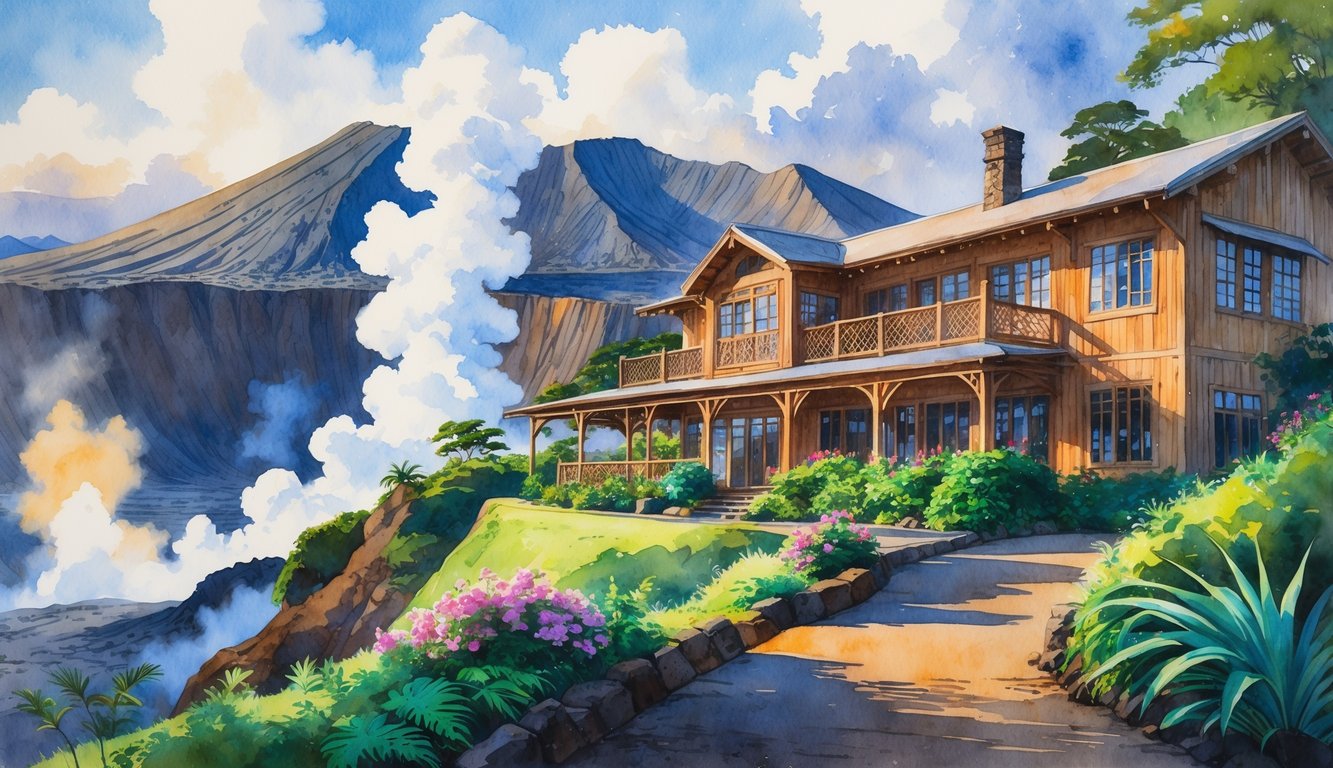
Volcano House is more than just a place to sleep. It blends history, comfort, and incredible views.
There are different room options, convenient dining, and useful guest services. My stay included everything I needed for a memorable visit.
Room Types and Crater View Rooms
Volcano House has 33 guest rooms, each with its own charm. I chose a crater view room so I could wake up to the sight of Halemaʻumaʻu Crater at the rim of Kīlauea.
These rooms are popular because the view is stunning, especially at sunrise. For travelers who want something more rustic, Volcano House also has 10 camper cabins and campsites.
These options are great for a budget-friendly stay and are close to the park’s trails and natural attractions. Every room, whether historic or new, feels cozy and inviting.
If you book ahead, ask about the crater-facing rooms for the best experience. The peaceful setting lets me enjoy privacy and the beauty of the national park.
Dining Experiences and Uncle George’s Lounge
The main dining room at Volcano House has large windows where I enjoyed meals while looking over the caldera. Breakfast, lunch, and dinner are served daily with menus featuring fresh, local ingredients.
A snack bar near the lobby offers quick bites. One of my favorite places to relax was Uncle George’s Lounge.
The lounge provides a friendly setting for drinks and light snacks. In the evenings, I watched the glow from the crater while sipping coffee or enjoying a cocktail.
The dining experience feels warm and local. The staff are knowledgeable and happy to share tips about the area.
Modern Facilities and Amenities
While staying at Volcano House, I had access to modern amenities that made my trip smoother. Free wireless internet (Wi-Fi) is available throughout the hotel and helped me share photos and keep in touch.
The lobby has a cozy lounge area that is perfect for reading or planning the next day’s hike. A small gift shop on-site sells souvenirs, maps, and local products.
Parking is easy and included with my stay. Daily housekeeping keeps everything tidy.
I appreciated details like warm bedding, complimentary coffee, and 24-hour front desk staff ready to help. The mix of old and new makes staying at Volcano House a unique experience in Hawaii.
Unique Experiences for Visitors
When I visit Volcano House, I find more than just a comfortable hotel with amazing views. There are many things to do, from outdoor adventures to discovering local art and culture.
I get to learn about volcanoes, join guided activities, and see creative work by local artists.
Guided Ranger Walks
I enjoy joining a ranger-guided walk. The rangers know a lot about Kīlauea, the landscape, and the wildlife.
They guide groups on trails near the caldera and explain the geology, history, and volcano legends. It’s a great way to ask questions and get firsthand knowledge.
The walks welcome people of most ages and fitness levels. Rangers sometimes point out special birds or show old lava flows.
I always feel safe because the rangers know the area well and keep everyone on the right path. The guided walks are included with my park entry.
I check the schedule at the Kīlauea Visitor Center for walk times. Each walk is different, depending on the time of day and volcanic activity.
There are handouts and displays at the visitor center so I can learn more before the walk begins.
Visitor Center Activities
At the Kīlauea Visitor Center, I discover activities to help me make the most of my visit. The park rangers answer questions and help me plan hikes or show me safe places to view the caldera.
There’s a spacious lobby with big windows where I can watch nature documentaries and see live displays about the volcano’s current activity. The exhibits are easy to understand and include maps, models, and real rock samples.
Junior ranger booklets for younger visitors make learning about the park fun and interactive. The visitor center also provides daily updates about weather, hiking conditions, and volcanic events.
I can borrow binoculars to view the crater from lookout points. There’s a small shop where I pick up maps, guidebooks, and handmade gifts from Big Island artists.
Art and Culture at Volcano Art Center
The Volcano Art Center is a highlight of my trip. The center is in a historic building by the caldera.
Inside, I see paintings, photography, wood carvings, and jewelry made by local artists. Most pieces celebrate the volcano, Hawaiian legends, or native plants and animals.
I enjoy walking through the gallery and sometimes meet the artists. There are hands-on workshops where I can try making art, like block printing or lei-making.
The center also holds cultural programs about Hawaiian traditions, music, and local history. Art shows change throughout the year, so each visit feels different.
The Volcano Art Center gift shop sells artworks I can bring home. Buying art here supports local artists and gives me a special reminder of my time on Kīlauea.
Outdoor Exploration and Hiking
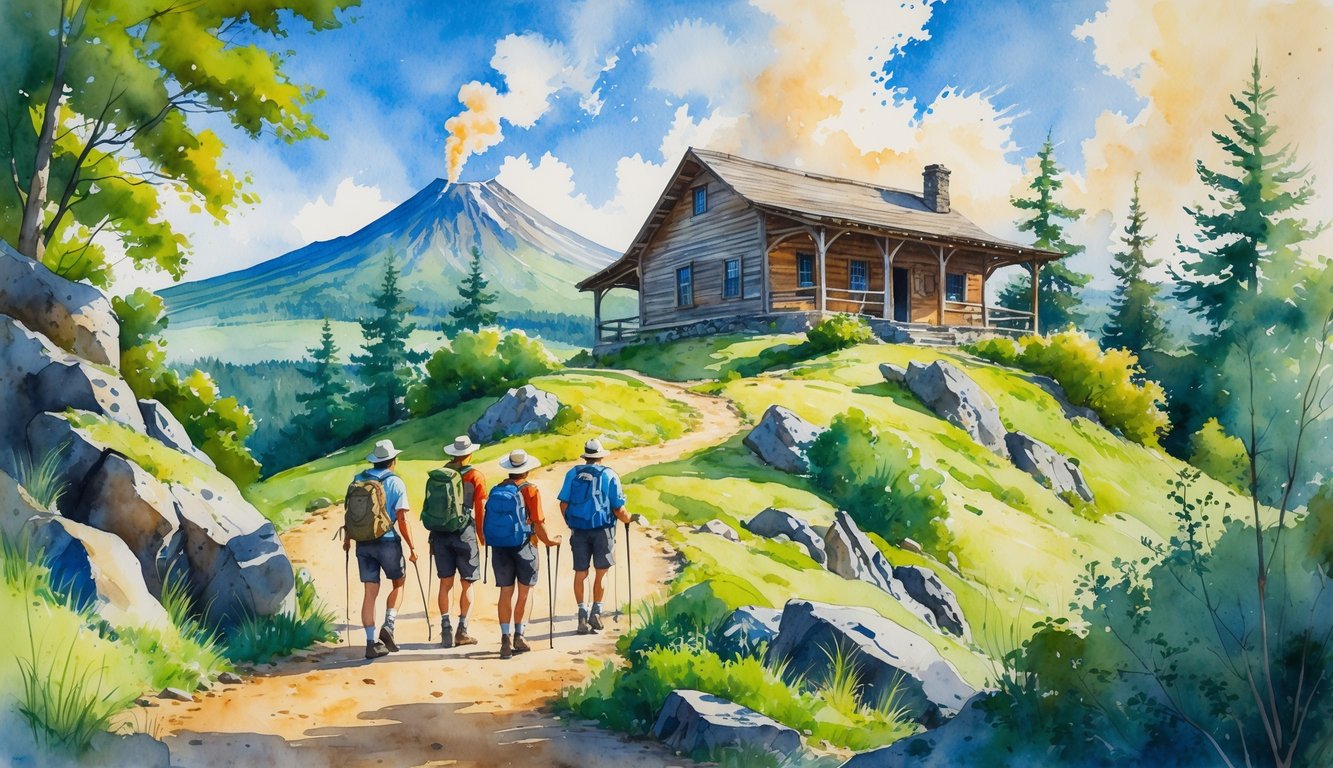
Exploring outside Volcano House lets me experience Hawaii’s natural landscape up close. The area is filled with scenic hiking trails and amazing wildlife.
Best Hiking Trails Near Volcano House
Some of the best trails start near Volcano House. The Kīlauea Iki Trail is a favorite for many visitors and myself because it takes you across a crater floor with hardened lava, lush forest, and steam vents.
The hike is about four miles round trip and offers unique views. The Crater Rim Trail is great if I want something easier but still beautiful.
This trail circles Kīlauea Caldera and travels through rain forest and open views of the crater edge. For a shorter walk, I recommend the Sulphur Banks Trail where I can see colorful mineral deposits and smell volcanic gases.
Each of these trails is located within Hawaii Volcanoes National Park, so I can enjoy different landscapes without driving far from the hotel.
Top Trail Picks Table
| Trail Name | Distance | Highlights |
|---|---|---|
| Kīlauea Iki | 4 miles RT | Lava fields, steam vents, forest |
| Crater Rim Trail | Varies | Caldera views, rain forest |
| Sulphur Banks | 1.2 miles RT | Mineral colors, volcanic gases |
Wildlife and Natural Surroundings
When I hike near Volcano House, I watch for native plants and birds. The ‘Ōhi‘a tree, with its bright red lehua blossoms, stands out along the trails.
This tree is important for the ecosystem and supports many native species. I often see the ʻapapane and ʻiʻiwi birds, which have striking red feathers and help pollinate the flowers.
The park is also home to rare birds like the nēnē, a Hawaiian goose. Sometimes I spot them in the grassy areas near the hotel.
There are small crickets, insects, and rainforest ferns that make the landscape feel alive. Steam vents and black lava rocks are everywhere, showing how volcanoes shape this place.
The mix of rugged terrain and living nature makes hiking around Volcano House an adventure. The views of the crater from the hotel’s crater view rooms let me enjoy nature even from my window.
Volcano Community and Surrounding Attractions
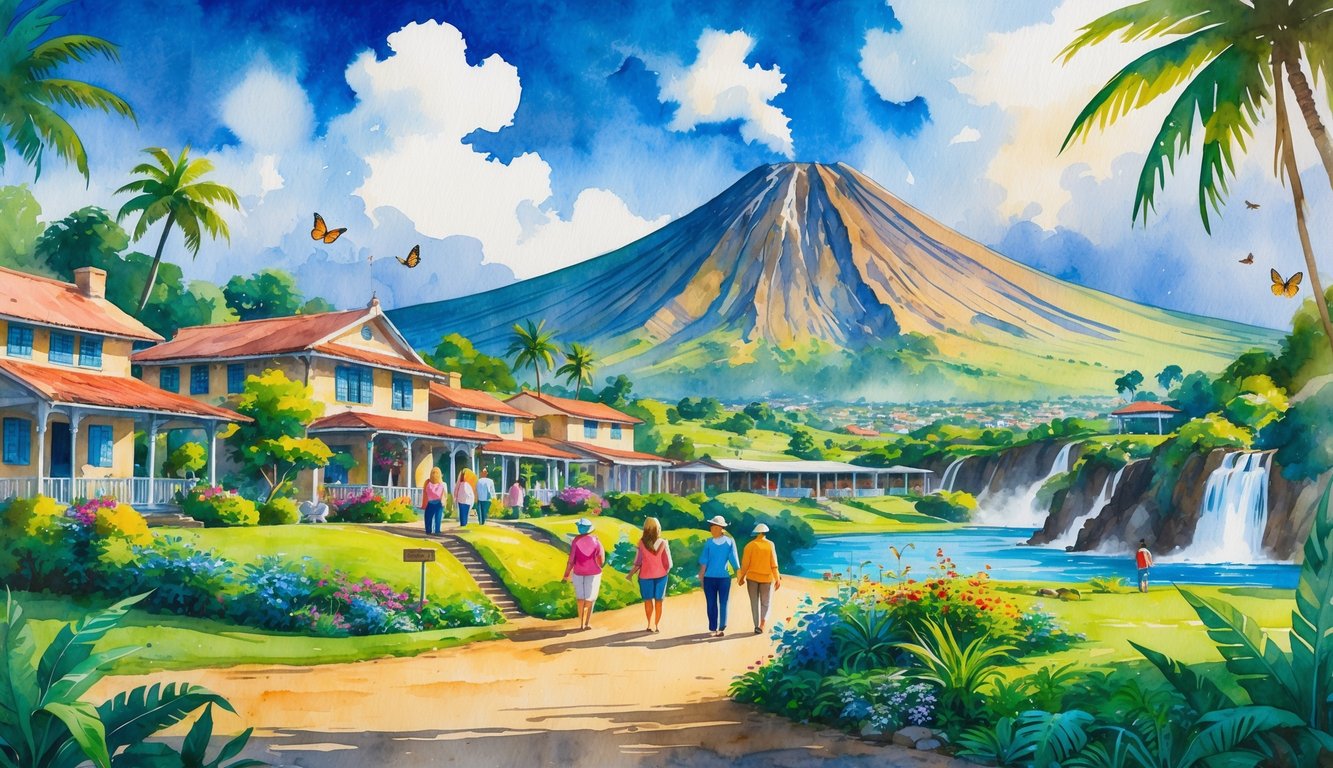
Volcano House puts me at the heart of a unique community full of charm. Beautiful nature is nearby, and there are interesting ways to get around.
The area blends local culture, small-town comforts, and a sense of adventure.
Exploring Volcano Village
Right outside Hawaii Volcanoes National Park sits Volcano Village. This small community feels peaceful, surrounded by tall trees and gardens.
I found small cafes, local art galleries, and friendly shops selling handmade goods. These local businesses give the area its special character.
There are walking paths and trails where I can experience the rainforest up close. Sometimes, I spot native birds or see bright orchids along the way.
For more art and culture, the Volcano Art Center is a short walk from the hotel. Stopping here gives me a glimpse of local creativity, right on the edge of the volcanic crater.
Regional Transportation and Interisland Steamship History
Before airplanes became common, most travelers reached the Big Island by interisland steamship. The Interisland Steamship Company ran these boats.
Passengers and supplies arrived at ports along the coast, then wagons or cars carried them up to Volcano House. The journey took longer, but it gave travelers a sense of adventure and anticipation.
Today, exploring the area is much easier. Well-maintained roads connect Volcano House with Hilo, Kailua-Kona, and other parts of the island.
Public transportation is limited, but car rentals are common. Learning this history of travel and access helps me appreciate how special—and accessible—this place is now.
Scientific and Cultural Significance
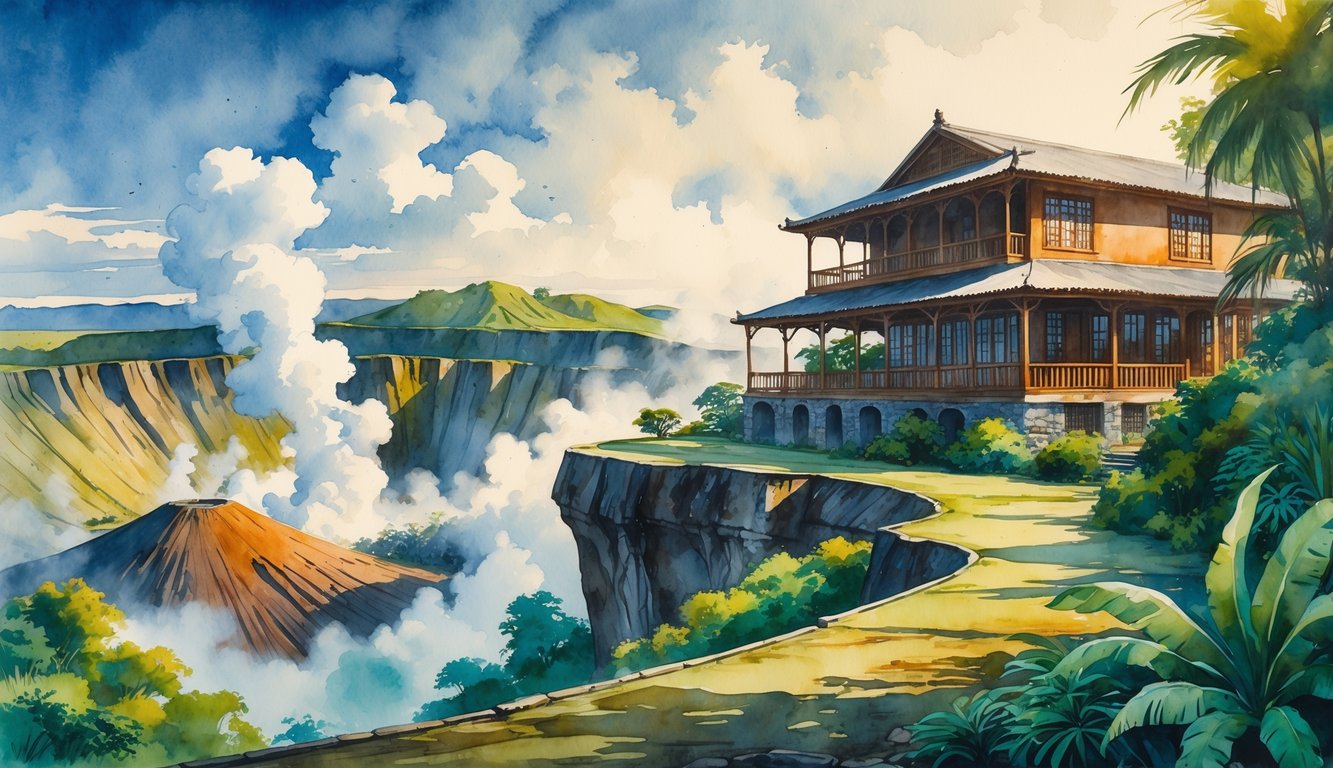
Visiting Volcano House gives me a rare look at where science and culture meet. I see real-time research on volcanoes and learn stories that go back hundreds of years.
Volcano Observatory at the Summit
At the summit of Kīlauea, the Hawaiian Volcano Observatory is where scientists watch and study one of the world’s most active volcanoes. Experts track lava flows, changes in gas, and earthquake activity almost every day.
The observatory began in 1912 and is an important place for learning about volcanoes. This site helps keep both locals and tourists safe by sharing warnings and updates.
From Volcano House, I can often watch the scientists at work or view data displays about recent activity. Standing close to the caldera, I get a unique perspective on how research shapes our understanding of volcanoes.
The observatory’s tools and discoveries make visiting Volcano House more interesting and informative. For more background on the role of the hotel and its location, visit the National Park Service history of Volcano House.
The Legend of Pele
Many Hawaiian stories connect Pele, the goddess of volcanoes and fire, to Kīlauea and the land around it.
Pele commands respect and inspires fear because she controls eruptions, lava, and the island’s shape.
People believe that Pele calls this area her home.
Traditions, songs, and dances celebrate her actions. She shapes the landscape and protects the land’s spirit.
Artifacts, old tales, and place names at Volcano House show her importance in local culture.
When I visit, I notice offerings and signs that ask for her blessing.
Staying near Kīlauea helps me understand why Hawaiian culture values Pele so highly.
Learn more about Pele’s connection to the area at the Storied History of Volcano House.




